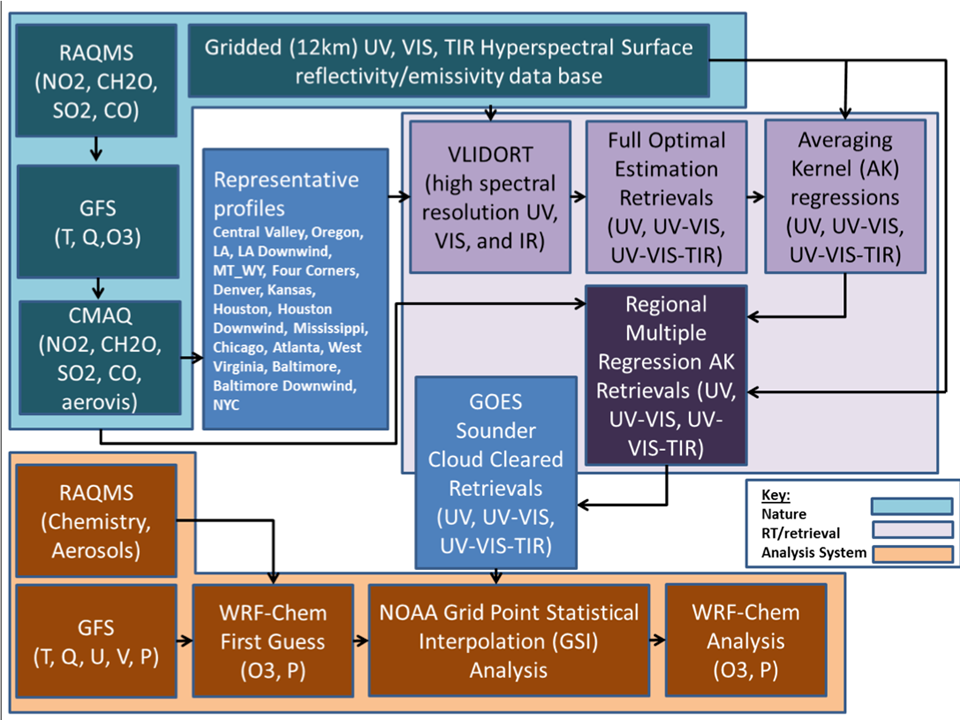
[ Archive ]

 |
CIMSS-NOAA Weekly Report
[ Archive ] |
 |
IN THE PRESS:
ITEMS FOR THE ADMINISTRATOR:
ITEMS FOR THE ASSISTANT ADMINISTRATOR:
ITEMS FOR THE OFFICE DIRECTOR, STAR:
Paper Published: The paper "Comment on 'Roles of interbasin frequency changes in the poleward shifts of the maximum intensity location of tropical cyclones'" by James P. Kossin (NOAA/NCEI/CWC), Kerry A. Emanuel (MIT) and Gabriel A. Vecchi (NOAA/GFDL) has been published in the journal Environmental Research Letters, and is available at http://iopscience.iop.org/article/10.1088/1748-9326/11/6/068001. (J. Kossin, NCEI/CWC, 608-213-6128)
TEMPO Science Team Meeting: Brad Pierce attended the 4th Tropospheric Emissions: Monitoring of Pollution (TEMPO) Science Team Meeting in Washington, DC. He presented an update on regional ozone Observation System Simulation Experiments (OSSE) conducted under the NASA Geostationary Coastal and Air Pollution Events (GEO-CAPE) Atmospheric Science Team Regional and Urban OSSE working group. TEMPO will provide geostationary UV-Vis ozone (O3), nitrogen dioxide (NO2), sulfur dioxide (SO2), and formaldehyde (HCHO) columns as well as aerosol optical depth (AOD) retrievals over greater North America and will be launched no later than 2021. The regional ozone OSSE was designed to assess the impact of geostationary ultra-violet (UV), UV plus visible (UV-Vis), and UV-Vis plus thermal infrared (UV-Vis-TIR) ozone retrievals on regional air quality predictions over the continental US during July 2011. The regional ozone OSSE compared the impacts of assimilating geostationary ozone retrievals to assimilation of current polar orbiting UV only retrievals from the NASA Ozone Monitoring Instrument (OMI). Results showed that assimilation of hourly geostationary UV, UV-Vis and UV-Vis-TIR ozone retrievals improves correlation, rms error and bias relative to control and current polar orbit retrievals. These OSSE results provide motivation for developing capabilities to assimilate TEMPO measurements within the National Weather Service (NWS) National Air Quality Forecasting Capability (NAQFC).
 (Click image to enlarge)
(Click image to enlarge)
Figure caption: Components of the regional OSSE include global and regional modeling systems and surface reflectively and emissivity data bases needed to generate the nature atmosphere (blue boxes), radiative transfer modeling systems and retrieval capabilities needed to generate the synthetic retrievals (purple boxes), and the global and regional data assimilation systems needed to assess the impacts of the synthetic retrievals on regional air qualilty (brown boxes).
ITEMS FOR THE DIVISION CHIEF, CoRP:
Presentation on GOES-R at 50th Annual CMOC: Bob Rabin (NSSL) gave a presentation on the capabilities of GOES-R to detect extreme weather events at the 50th annual Canadian Meteorological and Oceanographic Congress in Fredericton, NB this week. (R. Rabin, NOAA/NSSL and CIMSS, 608-264-5325/405-366-0583)VISITORS:
Local NWS Science Officer Visits CIMSS: On 24 May 2016, John Gagan, new Science and Operations Officer (SOO) at the National Weather Service (NWS) forecast office in Milwaukee/Sullivan, Wisconsin, along with three colleagues, Jerry Wiedenfeld, Information Technology Officer, Ben Herzog, Meteorologist Intern, and Steve Hentz, Lead Meteorologist, visited the Cooperative Institute for Meteorological Satellite Studies (CIMSS) to learn about research topics that have potential applications to operations. The group met with several CIMSS and Advanced Satellite Products Branch (ASPB) scientists. Since 2006, CIMSS has worked with NWS Milwaukee under their previous SOO, Jeff Craven, to make new satellite imagery and derived products available for evaluation in operations, and held local demonstrations to provide a line of communication to improve existing and new satellite products for end users. (J. Gerth, CIMSS, 608-263-4942, W. Feltz, CIMSS, 608-265-6283)
NEXT WEEK:
LOOKING AHEAD:
| Archived Weeklies Page | Submit a report item |